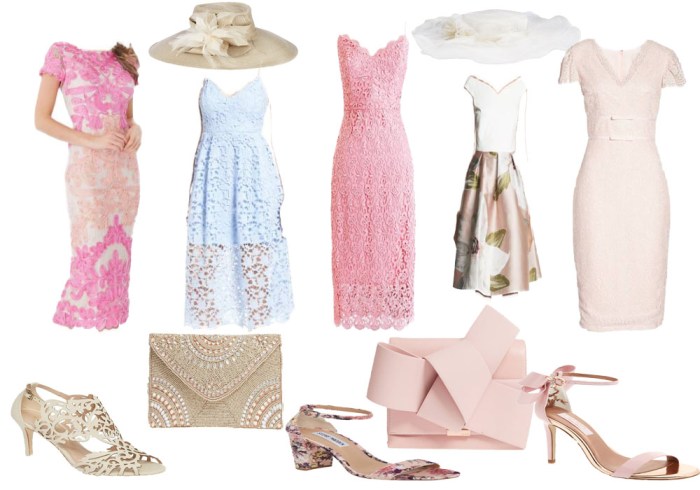Guest Dresses at Royal Weddings
A Regal History of Royal Wedding Guest Attire
Guest dresses at royal wedding – Royal weddings are more than just ceremonies; they’re elaborate spectacles of tradition, fashion, and societal observation. The guest attire, a vibrant tapestry woven with threads of history and current trends, offers a fascinating glimpse into the evolution of style and social norms. From the demure elegance of bygone eras to the modern interpretations of regal dressing, the guest list provides a captivating fashion parade.
Historical Context of Royal Wedding Guest Attire, Guest dresses at royal wedding
The evolution of royal wedding guest attire mirrors the broader shifts in fashion and social etiquette. Early royal weddings saw guests adorned in opulent gowns and elaborate embellishments, reflecting the wealth and power of the aristocracy. The Victorian era, for example, championed voluminous skirts, intricate lace, and dramatic silhouettes. The influence of societal norms is undeniable; dress codes reflected class distinctions, with the upper echelons showcasing extravagance while the lower classes adhered to simpler styles.
The transition into the 20th century brought about streamlined silhouettes, the rise of designers, and a gradual democratization of fashion, though a certain level of formality always remained.
Dress Code Expectations at Royal Weddings

Source: greenvelope.com
While specific dress codes vary, royal wedding invitations typically provide guidelines for appropriate attire. Historically, formal daywear or morning dress has been the norm for gentlemen, while ladies were expected to wear elegant dresses, often with hats. Unacceptable attire might include anything overly casual, revealing, or attention-grabbing. Violating the dress code, while unlikely to result in immediate expulsion, could certainly lead to awkward stares and whispered judgments.
After all, one wouldn’t want to upstage the happy couple.
Design Elements of Guest Dresses
Royal wedding guest dresses are a study in sophisticated elegance. Specific design elements consistently appear, reflecting timeless appeal and adherence to certain sartorial traditions.
| Neckline | Sleeve Length | Fabric | Embellishments |
|---|---|---|---|
| Round neck, V-neck, Boat neck | Long sleeves, three-quarter sleeves, sleeveless | Silk, lace, crepe, chiffon | Beading, embroidery, sequins, delicate appliqués |
Color choices are significant; pastels and muted tones are often preferred, avoiding anything too bold or distracting. The use of vibrant jewel tones can be seen, but usually in a more subtle and sophisticated manner. Millinery plays a crucial role, with hats completing the ensemble and adding a touch of refined formality. A well-chosen hat can elevate an outfit from elegant to truly regal.
Impact of Royal Weddings on Fashion Trends
Royal weddings often serve as significant catalysts for fashion trends. The influence extends beyond the bridal gown; guest attire significantly impacts broader style choices. For instance, certain silhouette trends or the popularity of specific fabrics and embellishments seen at a royal wedding can be mirrored in high-street fashion shortly after.
- Increased demand for specific fabrics or styles post-wedding.
- Inspiration for designers to incorporate royal wedding aesthetics into their collections.
- A boost in sales for brands associated with the event.
The Role of Designers and Brands
Renowned designers frequently dress guests at royal weddings, enhancing the prestige associated with the event. The opportunity to dress a guest at a royal wedding is a coveted achievement, showcasing the designer’s skill and elevating their brand’s profile. Designers often tailor their approach based on the individual guest’s style and the overall tone of the wedding, creating unique and memorable ensembles.
Social Media and Royal Wedding Fashion

Source: thestylineducator.com
Social media significantly shapes the perception and discussion of royal wedding guest attire. Instantaneous sharing and commentary create a global conversation, amplifying both positive and negative reactions. Viral moments often arise from particularly striking or unconventional outfits, showcasing the power of social media to influence fashion trends and public opinion.
Illustrative Examples of Guest Dresses
The following descriptions illustrate the diversity of styles seen at royal weddings:
- A flowing, floor-length gown in a soft blush pink silk, adorned with delicate lace appliqués and featuring a subtle v-neck and long sleeves. The overall effect was one of understated elegance, perfectly complementing the romantic atmosphere of the event.
- A sophisticated emerald green crepe dress with a defined waist and a midi-length skirt, accented by subtle beading along the neckline and sleeves. The structured silhouette provided a modern yet classic feel.
- A vibrant sapphire blue silk dress with a dramatic off-the-shoulder neckline and a fitted bodice that flowed into a full, A-line skirt. The rich color and bold silhouette created a truly unforgettable impression.
Helpful Answers: Guest Dresses At Royal Wedding
What are some common fashion faux pas to avoid at a royal wedding?
Avoid anything too casual (jeans, sneakers), overly revealing, or overtly themed (unless explicitly requested). Stick to elegant and respectful attire.
Are there specific color guidelines for guest dresses?
Generally, guests should avoid wearing white or ivory to avoid upstaging the bride. Otherwise, a wide range of colors is usually acceptable.
How important is the hat or headpiece?
For daytime royal weddings, a hat or fascinator is often considered essential, especially for more formal events. It adds to the overall elegance of the outfit.
What fabrics are typically seen in royal wedding guest dresses?
High-quality fabrics like silk, lace, crepe, and brocade are frequently chosen for their elegance and luxurious feel.



















